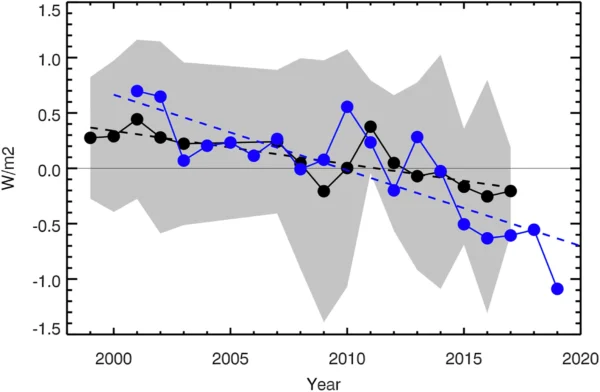The CERES estimates of the top-of-atmosphere radiative fluxes are available from 2001 to the present. That is long enough to see that there has been a noticeable trend in the Earth’s Energy Imbalance (EEI), mostly driven by a reduction in the solar radiation reflected by the planet, while the outgoing long wave radiation does not appear to contribute much. But what can be causing this?
A paper last year (Goode et al., 2021) also reported on a two decade estimate of Earthshine measurements which appear to confirm a small decrease in albedo (and decrease in reflected short wave (SW) radiation). While the two measurements are subtly different due to the distinct geometries, they do show sufficient coherence to give us some confidence that they are real.

Similarly, Loeb et al. (2021) show that the trends in the EEI derived from CERES match what you get from the changes in ocean heat content.

A few people have started to interpret the dominance of the SW trends to imply that the overall trends in climate are not (despite copious evidence) being driven by the rise in greenhouse gases (for instance, the rather poorly argued and seemingly un-copyedited Dübal and Vahrenholt (2021)) but these simplistic interpretations are seriously confused.
We can explore the issues and pitfalls of this using the ‘simple model’ of the greenhouse effect we explored back in 2007. At that time, we said:
[Read more…] about A CERES of fortunate events…You should think of these kinds of exercises as simple flim-flam detectors – if someone tries to convince you that they can do a simple calculation and prove everyone else wrong, think about what the same calculation would be in this more straightforward system and see whether the idea holds up. If it does, it might work in the real world (no guarantee though) – but if it doesn’t, then it’s most probably garbage.
References
- P.R. Goode, E. Pallé, A. Shoumko, S. Shoumko, P. Montañes‐Rodriguez, and S.E. Koonin, "Earth's Albedo 1998–2017 as Measured From Earthshine", Geophysical Research Letters, vol. 48, 2021. http://dx.doi.org/10.1029/2021GL094888
- N.G. Loeb, G.C. Johnson, T.J. Thorsen, J.M. Lyman, F.G. Rose, and S. Kato, "Satellite and Ocean Data Reveal Marked Increase in Earth’s Heating Rate", Geophysical Research Letters, vol. 48, 2021. http://dx.doi.org/10.1029/2021GL093047
- H. Dübal, and F. Vahrenholt, "Radiative Energy Flux Variation from 2001–2020", Atmosphere, vol. 12, pp. 1297, 2021. http://dx.doi.org/10.3390/atmos12101297




